함수와 프로토타입 체이닝 3
이 글은 고현준, 송형주 님의 인사이드 자바스크립트를참조하여 작성한 글입니다.
프로토타입 체이닝
프로토타입의 두 가지 의미
JS는 C++이나 Java 같은 객체지향 언어와 다른 프로토타입 기반의 객체지향 프로그래밍을 지원한다.
JS가 어떻게 OOP 기능을 제공하는지 이해하려면, 프로토타입과 프로토타입 체이닝에 대해 제대로 이해해야 한다.
Java와 같은 객체지향 프로그래밍에서는 클래스를 정의하고 이를 통해 객체를 생성하지만 JS에는 클래스 개념이 없다. 대신에 객체 리터럴이나, 생성자 함수로 객체를 생성하는데, 이렇게 생성된 객체의 부모 객체가 바로 Prototype 객체다. 자식 객체는 부모 객체가 가진 프로퍼티 접근이나 메소드 호출이 가능하다.
☝️ 참고로 최근의 ES6 문법에서는
Class문법이 추가되었으나 자바스크립트가 클래스 기반으로 바뀌었다는 것은 아니다.
JS의 모든 객체는 자신의 부모인 Prototype 객체를 가리키는 숨겨진 프로퍼티가 있는데 ECMAScript에서는 이를 **암묵적 프로토 타입 링크(Implicit prototype link)**라고 부르며 [[Prototype]] 라는 숨겨진 프로퍼티에 저장된다. (크롬이나 파이어폭스 같은 브라우저에서는 이를 __proto__ 프로퍼티로 명시적으로 제공하고 있다.)
그런데 함수 객체가 가지는 prototype 프로퍼티와 객체의 숨은 프로퍼티 [[Prototype]] 링크를 구분해야 한다. 이것이 바로 헷갈리기 쉬운 프로토타입의 두 가지 의미이다.
prototype 프로퍼티
JS에서 함수를 정의하면, 함수 생성과 동시에 Prototype 객체 가 생성된다. 그리고생성된 함수는 prototype 프로퍼티를 통해 Prototype 객체를 가리키게 된다.
Prototype 객체는 일반적인 객체와 같으며, 기본 속성으로 constructor 와 __proto__ 를 가지고 있다. 그리고 constructor 속성은 Prototype 객체와 함께생성되었던 함수를 가리킨다.
function myFunc() {}
console.dir(myFunc);
function myFunc() {}
console.dir(myFunc);
[출력 결과]

[[Prototype]] 링크( __proto__ )
이 [[Prototype]] 링크 속성은 모든 객체가 가지고 있는 속성이다. 이 속성은이 객체를 생성한 생성자 함수의 prototype 프로퍼티가 가리키는 Prototype 객체를 가리키고, 링크로 연결해 자신의 부모 객체로 설정한다.
// Person 생성자 함수
function Person(name) {
this.name = name;
}
// foo 객체 생성
var foo = new Person('foo');
console.dir(Person);
console.dir(foo);
// Person 생성자 함수
function Person(name) {
this.name = name;
}
// foo 객체 생성
var foo = new Person('foo');
console.dir(Person);
console.dir(foo);
[출력 결과]
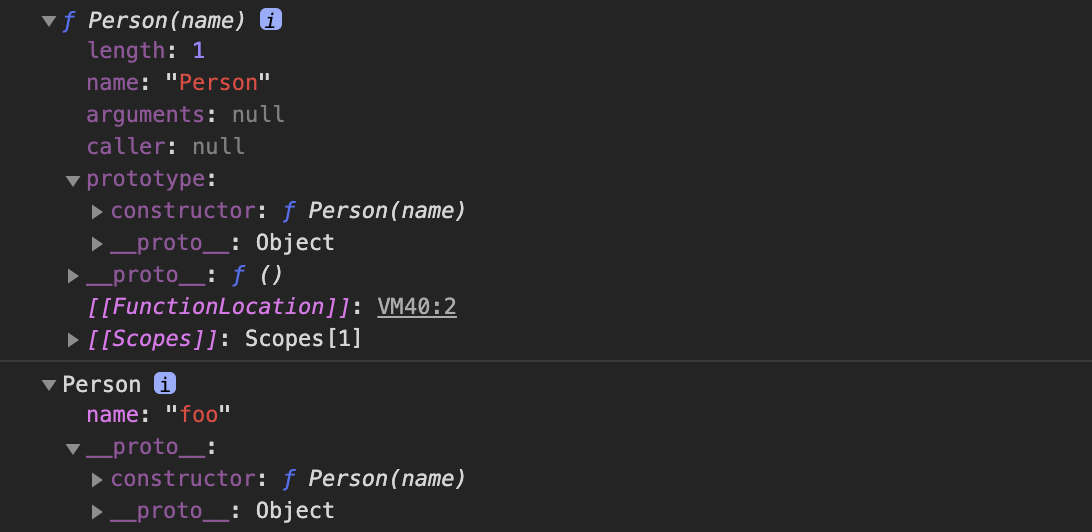
결과를 보면 Person() 생성자 함수의 prototype 프로퍼티와 foo 객체의 __proto__ 프로퍼티가 같은 Prototype 객체를 가리키고 있다.
또한 해당 Prototype 객체는 constructor() 프로퍼티가 Person() 생성자 함수를가리키고 있다.
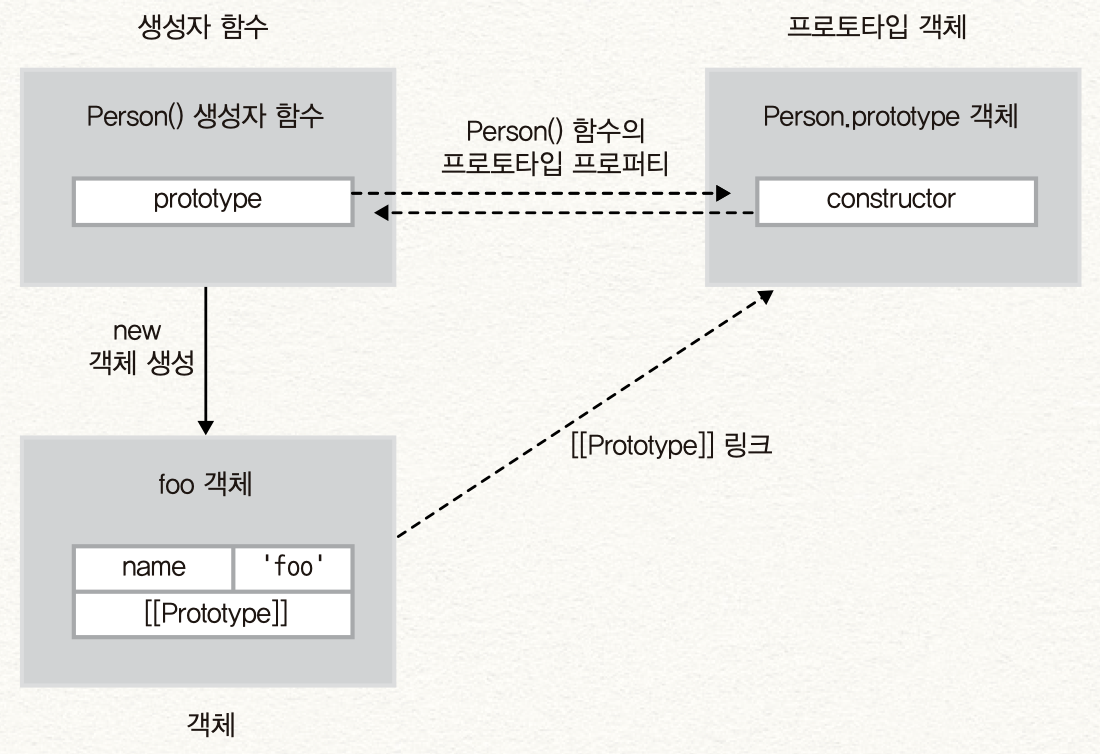
JS의 객체 생성 방식을 다시 한번 정리하면 이렇다.
생성자 함수(
Person())를 정의하면, 함수와 동시에Prototype객체(Person.prototype)이 생성된다.Person함수의prototype프로퍼티는Person.prototype을 가리키고,Person.prototype.constructor가Person()함수를 가리킨다.Person()함수로 생성된 객체(foo)는Person()함수의prototype프로퍼티가 가리키는Prototype객체를[[Prototype]]링크로 연결한다. (__proto__)
객체 리터럴 방식으로 생성된 프로토타입 체이닝
객체 리터럴 방식으로 객체를 생성하는 것도 결국 내부에서는 생성자 함수 Object() 를 사용하는 것임을 기억하자.
그리고 JS에서 객체는 자기 자신의 프로퍼티뿐만 아니라, 자신의 부모 역할을 하는 Prototype 객체의 프로퍼티를 자신의 것으로 접근하는 것이 가능하다. 이를 프로토타입 체이닝이라고 한다.
var myObject = {
name: 'foo',
sayName: function () {
console.log('My Name is ' + this.name);
},
};
myObject.sayName(); // My Name is foo
console.log(myObject.hasOwnProperty('name')); // true
console.log(myObject.hasOwnProperty('nickName')); // false
myObject.sayNickName(); // Uncaught TypeError: Object #<Object> has no method 'sayNickName'
var myObject = {
name: 'foo',
sayName: function () {
console.log('My Name is ' + this.name);
},
};
myObject.sayName(); // My Name is foo
console.log(myObject.hasOwnProperty('name')); // true
console.log(myObject.hasOwnProperty('nickName')); // false
myObject.sayNickName(); // Uncaught TypeError: Object #<Object> has no method 'sayNickName'
myObject 는 name 프로퍼티와 sayName() 메소드를 가진 객체이다. sayName() 메소드는 제대로 출력되지만, sayNickName() 메소드는 myObject 의 메소드가 아니므로 에러가 발생한다.
그런데 myObject 에는 hasOwnProperty() 라는 메소드가 없음에도 결과가 정상적으로 출력됐다.
이유는 다음과 같다.
객체 리터럴로 생성된 객체도 내장 생성자 함수
Object()를 통해 생성된 것이다 .생성자 함수
Object()역시 함수 객체이므로prototype프로퍼티를 갖고 있고,Object.prototype객체를 가리키고 있다.생성자 함수
Object()를 통해 생성된myObject객체는Object()함수의prototype프로퍼티가 가리키는Object.prototype객체를[[Prototype]]링크로 연결한다.JS에서 특정 객체의 프로퍼티나 메소드에 접근하려고 할 때, 접근하려는 프로퍼티또는 메소드가 없다면,
[[Prototype]]링크를 따라 자신의 부모 역할을 하는Prototype객체의 프로퍼티 또는 메소드를 차례대로 검색한다. (이를 프로토타입 체이닝이라고 한다.)Object.prototype객체는 모든 객체의 조상 역할을 하는 객체로서,toString(),hasOwnProperty()등의 표준 메소드를 갖고 있으므로, 이를 사용할 수 있다.
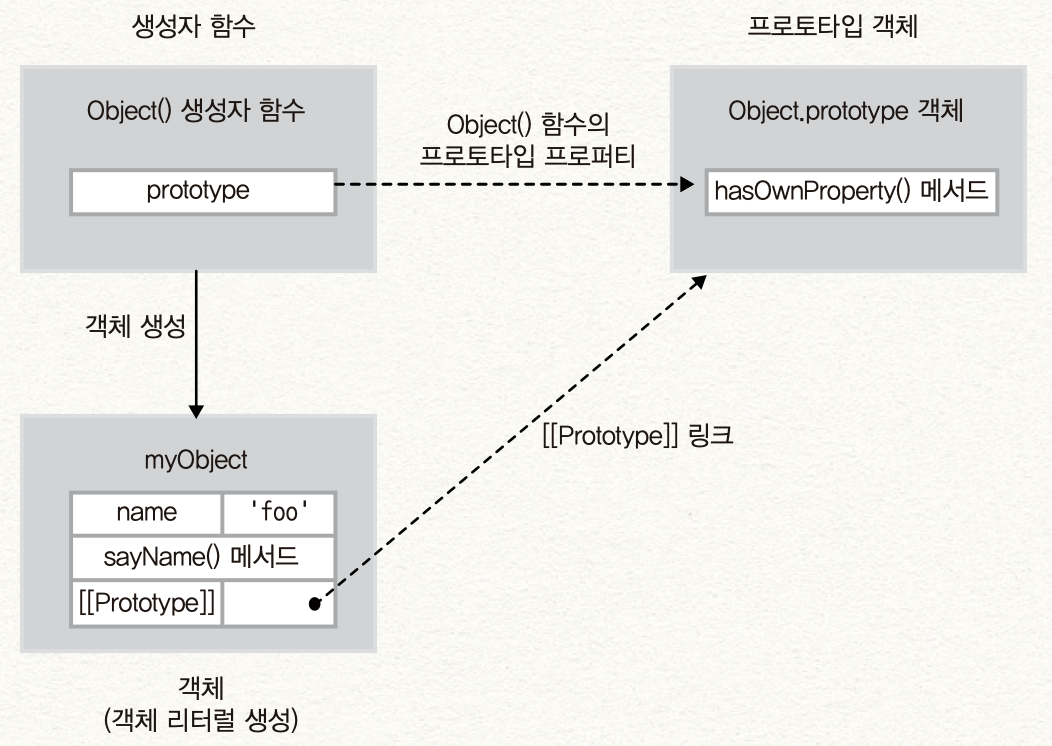
생성자 함수로 생성된 객체의 프로토타입 체이닝
그러면 객체 리터럴 방식이 아닌, 직접 정의한 생성자 함수로 객체를 생성하는 경우어떻게 프로토타입 체이닝이 동작하는지 알아보자.
// Person() 생성자 함수
function Person(name, age, hobby) {
this.name = name;
this.age = age;
this.hobby = hobby;
}
// foo 객체 생성
var foo = new Person('foo', 30, 'tennis');
// 프로토타입 체이닝
console.log(foo.hasOwnProperty('name')); // true
// Person.prototype 객체 출력
console.dir(Person.prototype);
// Person() 생성자 함수
function Person(name, age, hobby) {
this.name = name;
this.age = age;
this.hobby = hobby;
}
// foo 객체 생성
var foo = new Person('foo', 30, 'tennis');
// 프로토타입 체이닝
console.log(foo.hasOwnProperty('name')); // true
// Person.prototype 객체 출력
console.dir(Person.prototype);
위의 예제에서 foo 객체의 생성자는 Person() 함수이다. 따라서 foo 객체의 Prototype 객체는 자신을 생성한 Person() 함수의 prototype 프로퍼티가 가리키는 객체( Person.prototype )가 된다.
그런데 어떻게 Object.prototype 객체가 갖고 있는 표준 메소드인 hasOwnProperty() 를 사용할 수 있었을까?
foo.hasOwnProperty()메소드를 호출했을 때foo객체에는foo.hasOwnProperty()메소드가 없기 때문에 프로토타입 체이닝으로 부모 객체인Person.prototype에서hasOwnProperty()메소드를 찾는다.하지만,
Person.prototype객체는 디폴트로constructor프로퍼티만을 갖고 있으므로hasOwnProperty()메소드가 없다.Person.prototype객체 역시 JS 객체로, 모든 객체의 부모인Object.prototype을Prototype객체로 가진다. 따라서,Object.prototype에서hasOwnProperty()를 다시 검색하는 프로토타입 체이닝이 한번 더 일어나고, 표준 메소드들을 사용할 수 있다.
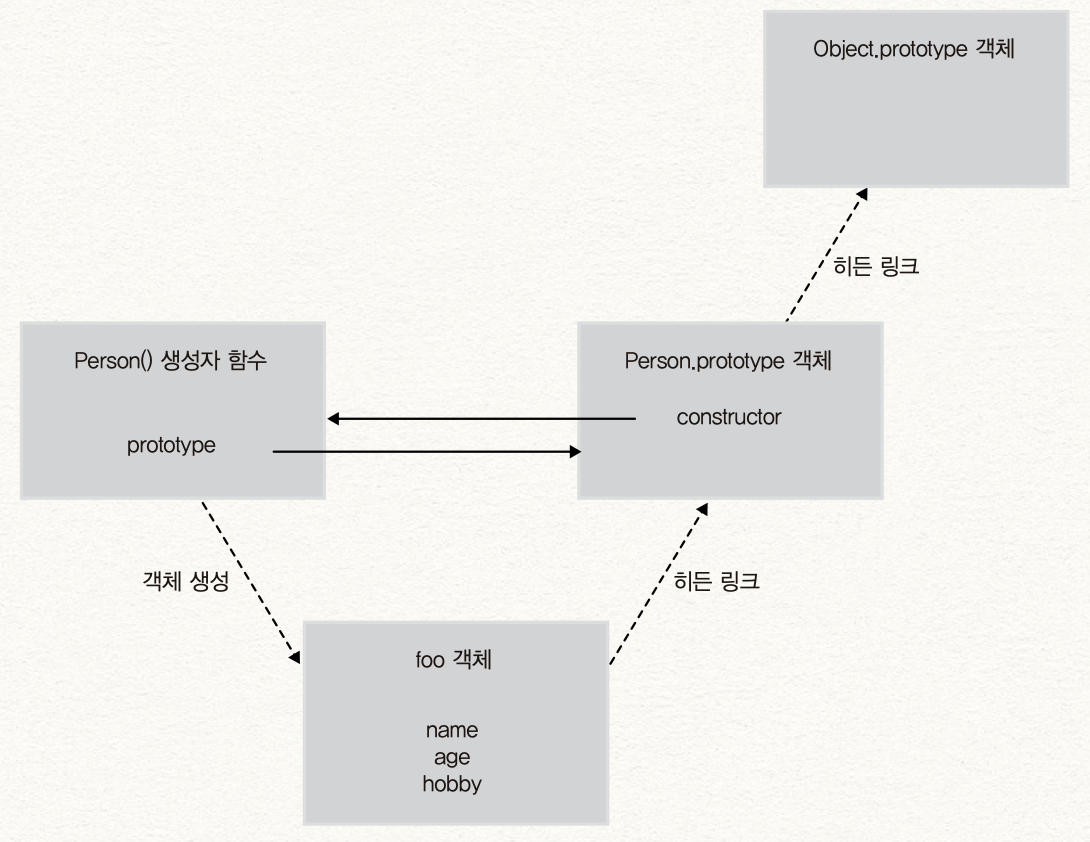
이렇게 객체 리터럴 방식과 직접 정의한 생성자 함수에서의 프로토타입 체이닝 방법에서 조금 차이가 있지만 결국 원칙은 같다.
"자바스크립트에서 모든 객체는 자신을 생성한 생성자 함수의
prototype프로퍼티가 가리키는 객체를 자신의Prototype객체(부모 객체)로 취급한다."
프로토타입 체이닝의 종점
앞서 살펴본 것처럼, Object.prototype 객체는 프로토타입 체이닝의 종점이다. 방식에 상관 없이 모든 객체는 프로토타입 체이닝으로 Object.prototype 객체가 가진 프로퍼티와 메소드에 접근 가능하고 서로 공유 가능하다.
기본 데이터 타입 확장
JS의 숫자, 문자열, 배열 등에서 사용하는 표준 메소드들의 경우 이들의 프로토타입인 Number.prototype , String.prototype , Array.prototype 에 정의되어 있다. 또한 이들 역시 Object.prototype 을 자신의 프로토타입으로 갖고 있어서 Object.prototype 의 메소드 역시 사용할 수 있다.
또한 JS는 표준 빌트인 Prototype 객체에 사용자가 직접 메소드를 정의해 추가하는것을 허용한다.
String.prototype.testMethod = function () {
console.log('This is the String.prototype.testMethod()');
};
var str = 'This is test';
str.testMethod();
console.dir(String.prototype);
String.prototype.testMethod = function () {
console.log('This is the String.prototype.testMethod()');
};
var str = 'This is test';
str.testMethod();
console.dir(String.prototype);
[출력 결과]
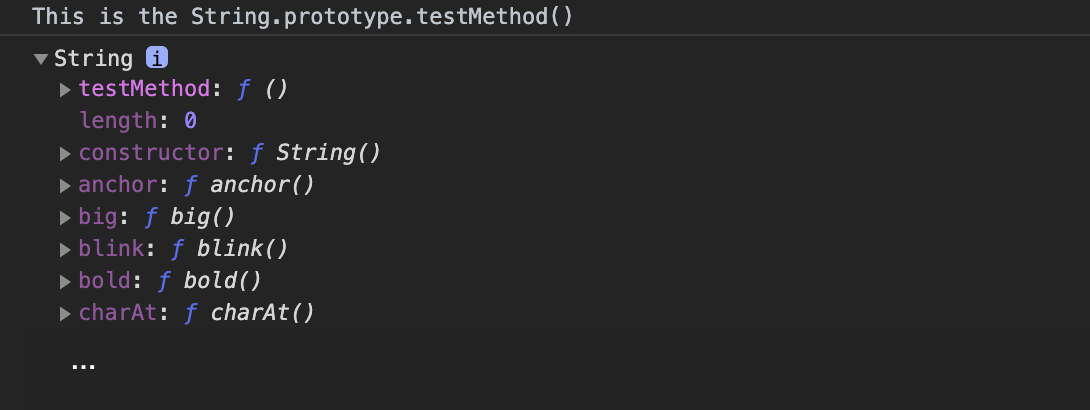
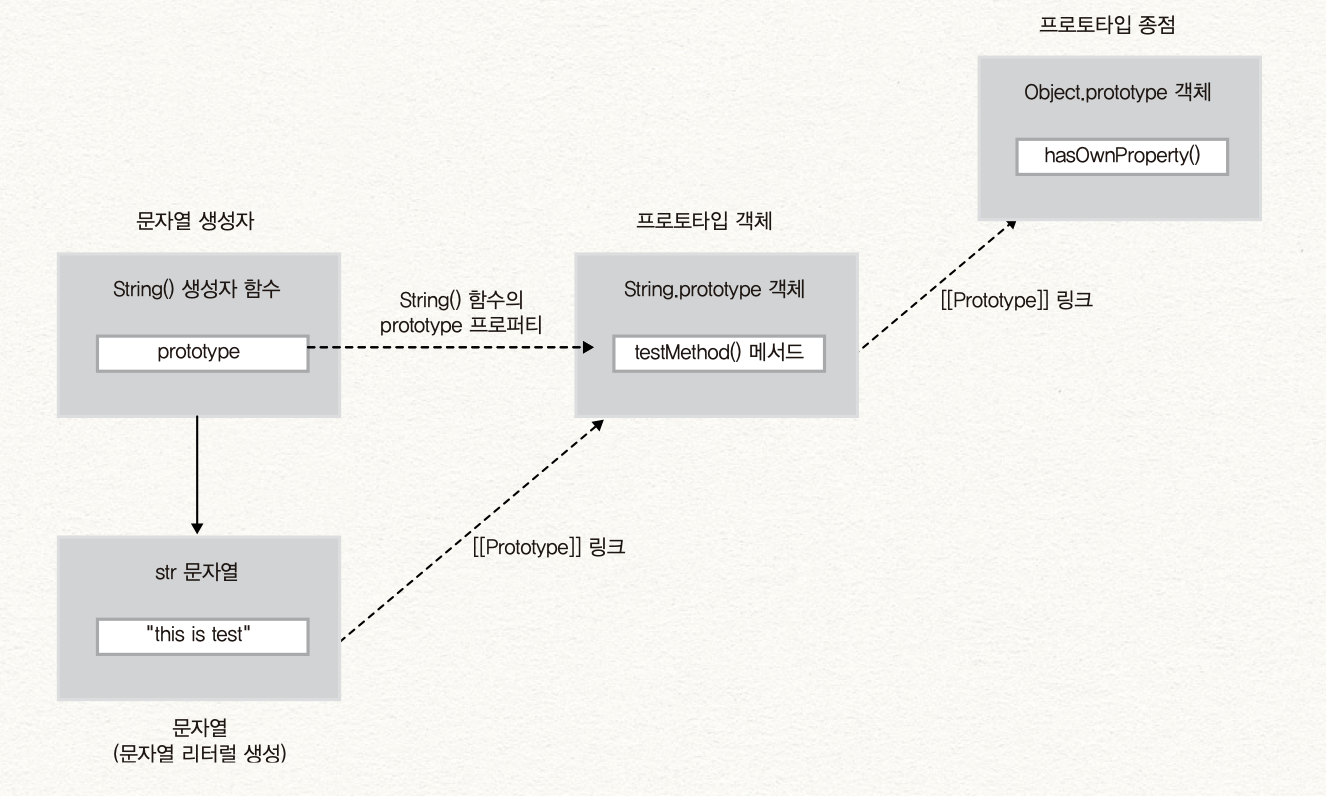
프로토타입도 자바스크립트 객체다
함수가 생성될 때, 자신의 prototype 프로퍼티에 연결되는 Prototype 객체는 디폴트로 constructor 프로퍼티만을 가진 객체다. 다시 말해 Prototype 객체 역시 자바스크립트 객체이다.
즉, 일반 객체처럼 동적 프로퍼티 추가/삭제가 가능하다. 이렇게 변경된 프로퍼티는실시간으로 프로토타입 체이닝에 반영된다.
// Person 생성자 함수
function Person(name) {
this.name = name;
}
// foo 객체 생성
var foo = new Person('foo');
// foo.sayHello();
// 이 시점에는 sayHello() 메소드가 foo 객체와 Person.prototype 객체 모두에 정의되어 있지 않으므로 에러가 발생한다.
// Prototype 객체에 sayHello() 메소드 정의
Person.prototype.sayHello = function () {
console.log('Hello');
};
foo.sayHello(); // Hello
// Person 생성자 함수
function Person(name) {
this.name = name;
}
// foo 객체 생성
var foo = new Person('foo');
// foo.sayHello();
// 이 시점에는 sayHello() 메소드가 foo 객체와 Person.prototype 객체 모두에 정의되어 있지 않으므로 에러가 발생한다.
// Prototype 객체에 sayHello() 메소드 정의
Person.prototype.sayHello = function () {
console.log('Hello');
};
foo.sayHello(); // Hello
foo 객체의 Prototype 객체인 Person.prototype 객체에 동적으로 sayHello() 메소드를 추가한 이후에는 foo 객체에 sayHello() 메소드가 없지만 프로토타입 체이닝으로 'Hello' 가 출력된다.
프로토타입 메소드와 this 바인딩
Prototype 객체는 메소드를 가질 수 있다. (이를 짧게 프로토타입 메소드라고부르기도 함.)
만약 프로토타입 메소드 내부에서 this 를 사용한다면 이는 어디에 바인딩될 것인가 ?
이는 앞서 살펴본 객체의 메소드를 호출할 때 this 바인딩 규칙과 동일하다. 즉 this 가 메소드를 호출한 객체에 바인딩된다.
// Person() 생성자 함수
function Person(name) {
this.name = name;
}
// getName() 프로토타입 메소드
Person.prototype.getName = function () {
return this.name;
};
// foo 객체 생성
var foo = new Person('foo');
console.log(foo.getName()); // foo
// Person.prototype 객체에 name 프로퍼티 동적 추가
Person.prototype.name = 'person';
console.log(Person.prototype.getName()); // person
// Person() 생성자 함수
function Person(name) {
this.name = name;
}
// getName() 프로토타입 메소드
Person.prototype.getName = function () {
return this.name;
};
// foo 객체 생성
var foo = new Person('foo');
console.log(foo.getName()); // foo
// Person.prototype 객체에 name 프로퍼티 동적 추가
Person.prototype.name = 'person';
console.log(Person.prototype.getName()); // person
디폴트 프로토타입은 다른 객체로 변경이 가능하다
앞에서 살펴본 것처럼 JS에서는 함수를 정의할 때, 함수 생성과 동시에 Prototype 객체가 생성되고, 생성된 함수의 prototype 프로퍼티가 Prototype 객체를 가리킨다.
이 함수 생성과 동시에 생성되는 Prototype 객체를 디폴트 프로토타입이라고 한다. 그런데, 이 디폴트 프로토타입 객체를 다른 일반 객체로 변경하는 것이 가능하다.
// Person() 생성자 함수
function Person(name) {
this.name = name;
}
console.log(Person.prototype.constructor);
// foo 객체 생성
var foo = new Person('foo');
console.log(foo.country);
// 디폴트 프로토타입 객체 변경
Person.prototype = {
country: 'korea',
};
console.log(Person.prototype.constructor);
// bar 객체 생성
var bar = new Person('bar');
console.log(foo.country);
console.log(bar.country);
console.log(foo.constructor);
console.log(bar.constructor);
// Person() 생성자 함수
function Person(name) {
this.name = name;
}
console.log(Person.prototype.constructor);
// foo 객체 생성
var foo = new Person('foo');
console.log(foo.country);
// 디폴트 프로토타입 객체 변경
Person.prototype = {
country: 'korea',
};
console.log(Person.prototype.constructor);
// bar 객체 생성
var bar = new Person('bar');
console.log(foo.country);
console.log(bar.country);
console.log(foo.constructor);
console.log(bar.constructor);
[출력 결과]
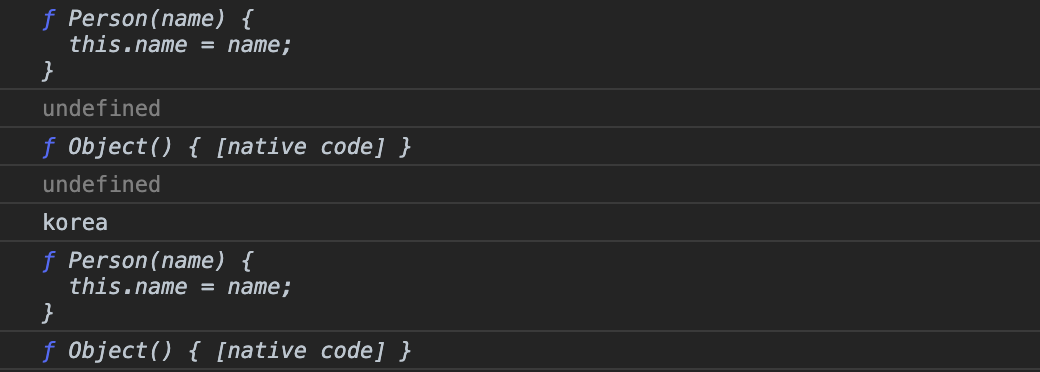
그런데 주의해야할 점이 있는데, 생성자 함수의 prototype 프로퍼티를 다른 일반 객체로 변경하면, 변경한 이후에 생성된 객체들은 변경된 Prototype 객체로 [[Prototype]] 링크를 연결한지만, 이전에 생성된 객체들은 기존 Prototype 객체로 [[Prototype]] 링크를 유지한다.
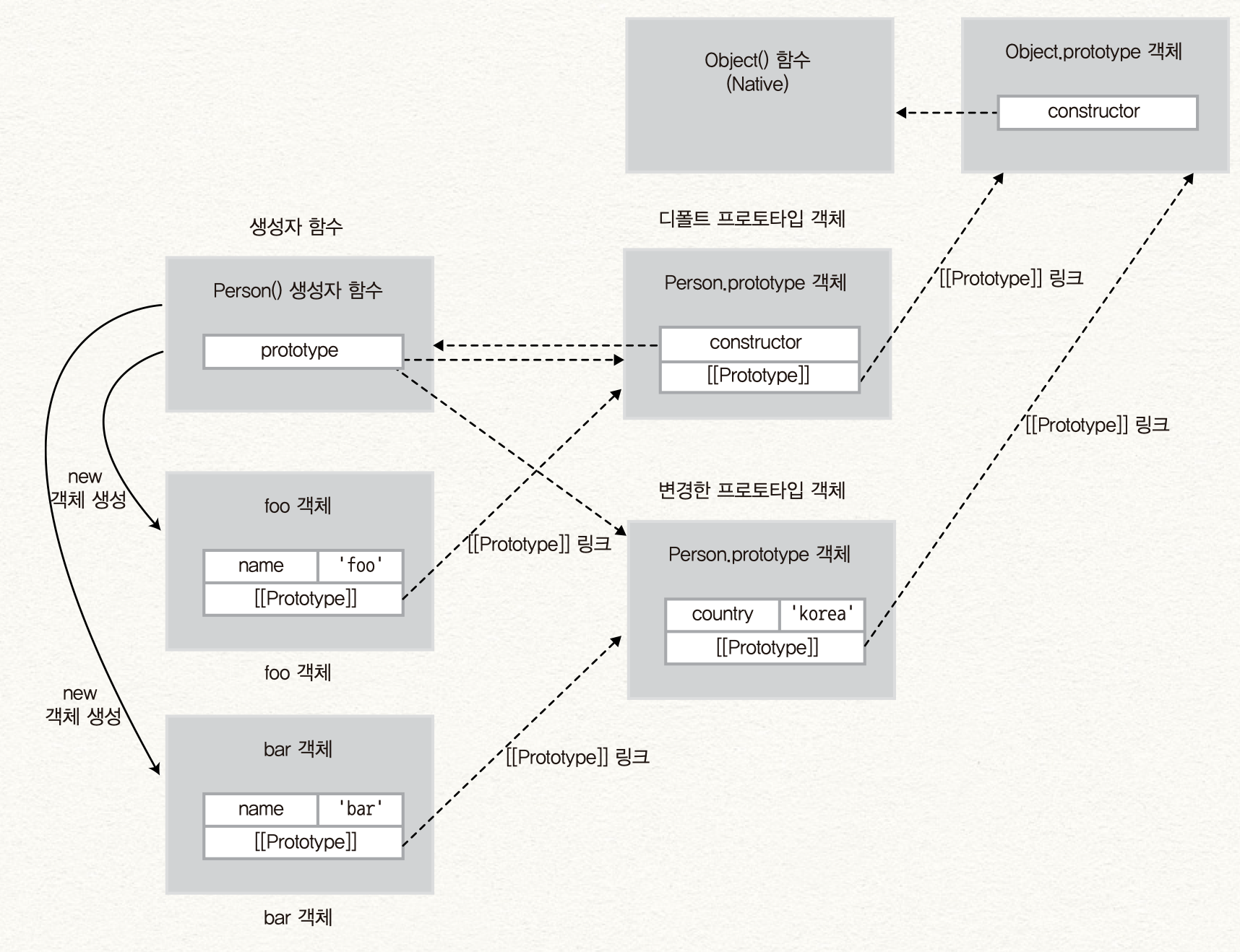
객체의 프로퍼티 읽기나 메소드를 실행할 때만 프로토타입 체이닝이 동작한다
프로토타입 체이닝은 객체의 프로퍼티를 읽으려고할 때, 메소드를 실행할 때만 동작하고 반대로 객체에 있는 특정 프로퍼티에 값을 쓰려고 할 때는 프로토타입 체이닝이 일어나지 않는다. 객체에 없는 프로퍼티에 값을 쓰려고 할 경우에는 동적으로 객체에 프로퍼티를 추가하기 때문이다.
// Person() 생성자 함수
function Person(name) {
this.name = name;
}
Person.prototype.country = 'Korea';
var foo = new Person('foo');
var bar = new Person('bar');
console.log(foo.country); // Korea
console.log(bar.country); // Korea
foo.country = 'USA';
console.log(foo.country); // USA
console.log(bar.country); // Korea
// Person() 생성자 함수
function Person(name) {
this.name = name;
}
Person.prototype.country = 'Korea';
var foo = new Person('foo');
var bar = new Person('bar');
console.log(foo.country); // Korea
console.log(bar.country); // Korea
foo.country = 'USA';
console.log(foo.country); // USA
console.log(bar.country); // Korea
foo.country 를 'USA'로 수정하였지만, bar.country 는 그대로 'Korea'인데, 이는 Person.prototype.country 가 수정되지 않았기 때문이다.
 Younho9 Notes
Younho9 Notes